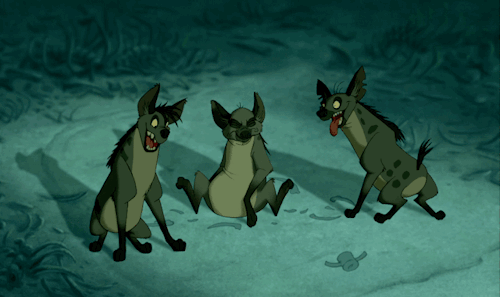Yes, I'm Revisiting Racism in "The Lion King"
I know I've already devoted some articles to discussing racism in "The Lion King" (linked here and here), but after our class discussions on the topic I've decided to revisit it. Primarily, I want to respond to Robert Gooding-Williams essay on "The Lion King" and racism.
I didn't know what to think of the article when I first read it, or even when I sat in class today. But after having some time to think it over and hearing what my peers had to say, I now have a very strong opinion on some of Gooding-William's key points.
I do believe Disney was being stereotypical—whether intentional or not—in casting the hyenas for the film. Whoopi Goldberg and Cheech Marin—both minorities—voice Shenzi and Banzai. But in arguing for this racism, many people often forget the third hyena. Ed, the stupidest hyena of them all, is voiced by Jim Cummings, a white actor. So yes, Disney could have done better in picking its voice actors for the roles in the film, but it wasn't trying to draw a harsh divide between whites and minorities. Otherwise, Jim Cummings would have been placed on the other side of that line.
Another argument that stood out to me was Gooding-William's claim that the hyena's home is "a bleak-looking and overcrowded hi-rise, the unambiguous image of a housing development in the projects." The housing developments in the projects do not have a monopoly on bleak-looking buildings. Yes, the hyenas' home is dark and dreary, and perhaps the projects are as well—but it does not make the similarities intentional. Disney worked to create a villainous lair just like all other villainous lairs, from Ursula's to Judge Frollo's: downcast and the perfect home for evil plotting. It doesn't mean it depicts the inner cities just because the inner cities could share one or numerous of the same characteristics.
My last comment on Gooding-William's article discusses his argument that Disney implies minorities in gentrified places lead to widespread destruction. Again, if there were a clear divide between minorities and whites, I would understand this. But Ed the evil hyena is white, while Rafiki, Sarabi, and Nala (all "good guys") are black. Timon and Pumbaa, voiced by white actors, don't even exist in this "circle of life." So how is Disney making a social commentary, then, if in the film minorities do exist in gentrified places and do so peacefully (ex. Rafiki, Sarabi, and Nala)? And what about the white characters who exist outside the gentrified places (ex. Ed, Timon, and Pumbaa)?
Do I agree with Gooding-Williams that Disney could have done some more research and made "The Lion King"'s Africa a little less Eurocentric? Absolutely. Do I believe the company went so far as to turn the film into a politically charged film advancing its racist agenda? Not a chance. Disney has been racist in the past, and I would argue that in some ways "The Lion King" is racist, too—but not in the ways that Gooding-Williams argues.


Comments
Post a Comment